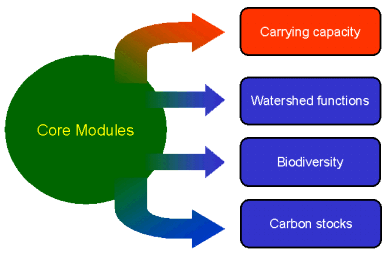

Introduction
Core modules
Additional modules
Impacts modules
Introduction
The FALLOW model has been developed as impact assessment tool
at landscape level to help integrate our understanding of landscape-mosaic-resource
interactions (van Noordwijk, 2002). It considers
roles of actors/stake-holders in transforming the landscape, biophysical
responses from plot- to landscape-levels through explicit scaling rules,
and actors’/stake-holders’ feedbacks on the changing landscape.
Structure
of FALLOW model is stratified into three parts: (1) core
modules as the heart of the model; (2) additional modules
as supporting modules that can be optional; and (3) impacts
modules as impacts assessment toolbox.
back to top
Core
modules
The loop of dynamic modules of FALLOW (see diagram) can be understood
by starting from the dynamics of soil fertility at plot-level based on
the simple Trenbath model (van Noordwijk, 1999),
where soil fertility is depleted during cropping periods and recovers
during fallow period. Current fertility at plot-scale determines agricultural
crop yield (depending on crop type, with stochastic effects of weather,
pest and diseases). Total crop production from the whole landscape together
with the yield gained from other economical production systems (e.g. agroforestry,
forest resource utilisation activities, monoculture plantations) contributes
to food sufficiency and/or household economical resources. People, starting
from initial knowledge and learning from experience during the simulation,
will make strategic decisions regarding agricultural land demand and/or
labour allocation for various economical production activities. Once agricultural
land demand is determined, people will select suitable plots for clearing
and planting based on their estimates of attractiveness of the plots,
which integrates relative soil fertility and land accessibility with regards
to transportation costs, land tenure status and spatially explicit rules
on forest reserves. The choice of crop to be cultivated may be based on
people’s knowledge about crop response to soil fertility. Activities
related to agricultural land expansion will disturb natural succession
as well as soil fertility recovery processes of the cleared plots.
Blue buttons represent biophysical processes, red buttons represent
socio-economic processes.
Additional
modules
FALLOW initially focussed on the transition from a shifting cultivation
system to more intensive crop-fallow rotations, but has been augmented
to include ‘agroforests’ and other land use options and successional
series (van Noordwijk, 2002). Currently FALLOW
has incorporated further sequences of land use and/or natural resource
utilisation systems, ranging from agroforestry system to monoculture plantation
systems.
Blue buttons
represent biophysical processes, red buttons represent socio-economic
processes.

back to top
Impacts modules
Moreover, FALLOW provides toolboxes to assess the consequences of landscape
dynamics in terms of human carrying capacity (food sufficiency), watershed
functions, biodiversity and carbon stocks.
Blue buttons represent biophysical processes, red buttons represent
socio-economic processes.

back to top
